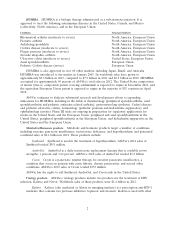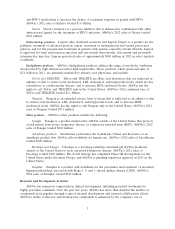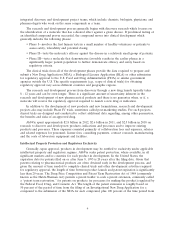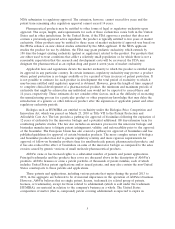AbbVie 2012 Annual Report Download - page 18
Download and view the complete annual report
Please find page 18 of the 2012 AbbVie annual report below. You can navigate through the pages in the report by either clicking on the pages listed below, or by using the keyword search tool below to find specific information within the annual report.AbbVie expects debate to continue during 2013 at all government levels worldwide over the
marketing, availability, method of delivery, and payment for health care products and services. AbbVie
believes that future legislation and regulation in the markets it serves could affect access to health care
products and services, increase rebates, reduce prices or the rate of price increases for health care
products and services, change health care delivery systems, create new fees and obligations for the
pharmaceuticals industry, or require additional reporting and disclosure. It is not possible to predict the
extent to which AbbVie or the health care industry in general might be affected by the matters
discussed above.
AbbVie is subject to a Corporate Integrity Agreement (CIA) entered into by Abbott on May 7,
2012 that requires enhancements to AbbVie’s compliance program and contains reporting obligations,
including disclosure of financial payments to doctors. If AbbVie fails to comply with the CIA, the
Office of Inspector General for the U.S. Department of Health and Human Services may impose
monetary penalties or exclude AbbVie from federal health care programs, including Medicare and
Medicaid.
European Union. The EU has adopted directives and other legislation governing labeling,
advertising, distribution, supply, pharmacovigilance, and marketing of pharmaceutical products. Such
legislation provides mandatory standards throughout the EU and permits member states to supplement
these standards with additional regulations. European governments also regulate pharmaceutical
product prices through their control of national health care systems that fund a large part of the cost of
such products to consumers. As a result, patients are unlikely to use a pharmaceutical product that is
not reimbursed by the government. In many European countries, the government either regulates the
pricing of a new product at launch or subsequent to launch through direct price controls or reference
pricing. In recent years, many countries have also imposed new or additional cost containment
measures on pharmaceutical products. Differences between national pricing regimes create price
differentials within the EU that can lead to significant parallel trade in pharmaceutical products.
Most governments also promote generic substitution by mandating or permitting a pharmacist to
substitute a different manufacturer’s generic version of a pharmaceutical product for the one prescribed
and by permitting or mandating that health care professionals prescribe generic versions in certain
circumstances. In addition, governments use reimbursement lists to limit the pharmaceutical products
that are eligible for reimbursement by national health care systems.
Japan. In Japan, the National Health Insurance system maintains a Drug Price List specifying
which pharmaceutical products are eligible for reimbursement, and the Ministry of Health, Labour and
Welfare sets the prices of the products on this list. The government generally introduces price cut
rounds every other year and also mandates price decreases for specific products. New products judged
innovative or useful, that are indicated for pediatric use, or that target orphan or small population
diseases, however, may be eligible for a pricing premium. The government has also promoted the use
of generics, where available.
Emerging Markets. Many emerging markets take steps to reduce pharmaceutical product prices, in
some cases through direct price controls and in others through the promotion of generic alternatives to
branded pharmaceuticals.
Since AbbVie markets its products worldwide, certain products of a local nature and variations of
product lines must also meet other local regulatory requirements. Certain additional risks are inherent
in conducting business outside the United States, including price and currency exchange controls,
changes in currency exchange rates, limitations on participation in local enterprises, expropriation,
nationalization, and other governmental action.
12
























